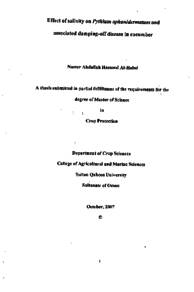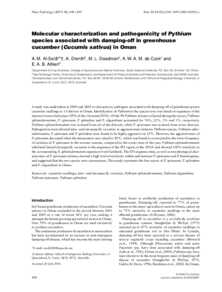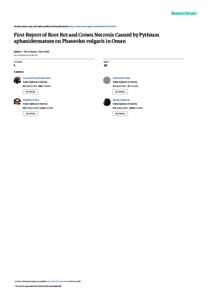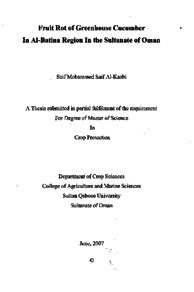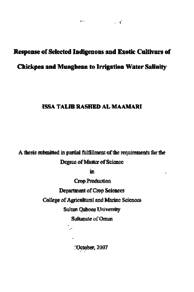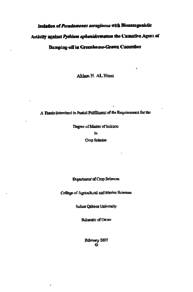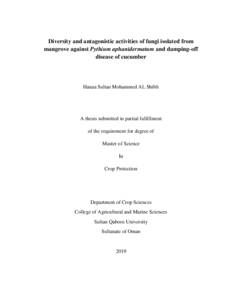Document
Effect of salinity on Pythium aphanidermatum and associated damping-off disease in cucumber
Publisher
Sultan Qaboos University
Gregorian
2007
Language
English
English abstract
This series of experiments examined the effect of raised levels of salinity on the growth and reproduction of Pythium aphanidermatum in culture and investigated synergy between salinity and pathogen in the development of damping-off of greenhouse cucumber seedlings. The temporal progress of damping-off on cucumber seedlings was significantly increased when seedlings were irrigated with water at raised levels of salinity, the mortality after seven days being higher at 5.0 dS/m (0.98) than at 0.02 dS/m (0.47). Non-linear regression analsyis was used to obtained logistic model parameter estimates. These indicated that the time taken for 50% of seedlings to become infected was reduced from 5.9 days at 0.02 dS/m to 3.7 days under the higher salinity levels of 5.0 dS/m. Asymptotic disease levels were also increased from 0.69 at 0.02 dS/m to 1.00 at 5.0 dS/m. Increased salinity levels did not have an effect on the growth rate parameter of the logistic regression model.
Plant dry weight seven days after inoculation with P. aphanidermatum was significantly reduced as salinity increased (P = 0.042).
Mycelial growth rate in sand at 50.0 dS/m (0.30 mm/h) was not significantly different (P = 0.381) to that at 0.02 ds/m (0.36 mm/hr) suggesting extreme salinity tolerance in P. aphanidermatum. However, sexual reproduction was compromised, but only prevented at the highest levels of salinity. Oogonium production decreased exponentially (R' = 0.902) with increasing salinity and no oogonia were produced at 30.0 dS/m. Oospore size was significantly smaller (P<0.001) at 20.0 dS/m than at 0.02 dS/m. Oospores produced at all salinity levels were found to have the same viability as those produced at 0.02 dS/m.
The production of pectin degrading enzymes is an important component in the development of diseases caused by Pythium species. Degradation of pectin was measured using a viscometer to quantify the effect of increasing salinity on the ability of P. aphanidermatum to liquefy the substrate. Liquefaction of pectin progressed more slowly as salinity levels increased but was still considered sufficient to indicate that disease development would not be prevented at high salinity levels.
The synergy between pathogen and salinity in the development of crop diseases in the greenhouses of Oman is discussed in the light of the increasingly problem of sea water intrusion in the Al Batinah region of Oman, the increasing importance of greenhouse production in this region and the farmer-based decisions used in crop management. This series of experiments examined the effect of raised levels of salinity on the growth and reproduction of Pythium aphanidermatum in culture and investigated synergy between salinity and pathogen in the development of damping-off of greenhouse cucumber seedlings. The temporal progress of damping-off on cucumber seedlings was significantly increased when seedlings were irrigated with water at raised levels of salinity, the mortality after seven days being higher at 5.0 dS/m (0.98) than at 0.02 dS/m (0.47). Non-linear regression analsyis was used to obtained logistic model parameter estimates. These indicated that the time taken for 50% of seedlings to become infected was reduced from 5.9 days at 0.02 dS/m to 3.7 days under the higher salinity levels of 5.0 dS/m. Asymptotic disease levels were also increased from 0.69 at 0.02 dS/m to 1.00 at 5.0 dS/m. Increased salinity levels did not have an effect on the growth rate parameter of the logistic regression model. Plant dry weight seven days after inoculation with P. aphanidermatum was significantly reduced as salinity increased (P = 0.042). Mycelial growth rate in sand at 50.0 dS/m (0.30 mm/h) was not significantly different (P = 0.381) to that at 0.02 ds/m (0.36 mm/hr) suggesting extreme salinity tolerance in P.aphanidermatum. However, sexual reproduction was compromised, but only prevented at the highest levels of salinity. Oogonium production decreased exponentially (R' = 0.902) with increasing salinity and no oogonia were produced at 30.0 dS/m. Oospore size was significantly smaller (P<0.001) at 20.0 dS/m than at 0.02 dS/m. Oospores produced at all salinity levels were found to have the same viability as those produced at 0.02 dS/m. The production of pectin degrading enzymes is an important component in the development of diseases caused by Pythium species. Degradation of pectin was measured using a viscometer to quantify the effect of increasing salinity on the ability of P. aphanidermatum to liquefy the substrate. Liquefaction of pectin progressed more slowly as salinity levels increased but was still considered sufficient to indicate that disease development would not be prevented at high salinity levels. The synergy between pathogen and salinity in the development of crop diseases in the greenhouses of Oman is discussed in the light of the increasingly problem of sea water intrusion in the Al Batinah region of Oman, the increasing importance of greenhouse production in this region and the farmer-based decisions used in crop management.
Description
Thesis
Member of
Resource URL
Arabic abstract
تأثير الملوحة على فطر Pythium aphanidermatum وعلاقتة بمرض الأول في الخيار الهدف من اجراء هذا البحث هو اختبار تأثير ارتفاع الملوحة على نمو هيفات الفطر المسبب لذبول شتلات الخيار والمسمى بالد Pythium ، كذالك دراسة تأثير الملوحة على الأعضاء التكاثرية لهذا الفطر وبالتالي معرفة العلاقه الناتجه بينهما والتي بدورها تكون المسبب لمرض دول شتلات خيار البيوت المحمية التطور الحالي لمرض الذيول في شتول الخيار هو في تزايد مستمر وخصوصا عندما تروي هده الشتلات بمياه تكون الملوحه فيها عالية نتيجة تداخل ملوحة مياه البحر المالحة مع المياه العذبة نتيجة الاستنزاف الزائد لهده المياه. ذبول الشتلات في اليوم السابع من الشتل وبعد يومين من حقن فطرہ aphanidermatum Pythium في التربية مباشرة كان بدرجة عالية عند درجة ملوحة تساوي 5 0 . 98nS / m ) مقارنة بدرجة ملوحة تساوي S / m002 0 . 47) . انخفض وزن المادة الجافة انخفاضا حادا للشتلات كلما ازدادت درجة الملوحة. عند المقارنة بين نمو هيفات الفطر عند درجة ملوحة ( dS / m50) ودرجة ملوحة (02) فان الفرق ضئيل جدا بين التموين على عكس النمو الطبيعي للهيفات في الملوحة العالية فان أعداد البويضات الأولية الفطر قد سجلت انخفاضا شديدا بعد درجة ملوحة تساوي ( S / m20 وانعدمت عند درجة ملوحة تساوي 30/dS. أحجام بذور الفطر كانت معنويا اصغر عند درجة ملوحة ( 20 dS / m ) مقارنة مع أحجامها عند درجة ملوحة (02، ). لم تتأثر حيوية نمو بذور الفطر الناتجة تحت ظروف ملحية تساوي (20 S / m . يعد افراز الفطر لانزيم البكتياز من أهم عوامل تطور نمو المرض للخضار المزروعة داخل البيوت المحمية وقد تم فحص تأثير الملوحة على إفراز الفطر لهذا اللإنزيم المحطم لجدار خلية النبات تحت تاثير تراكيز مختلفة من الملوحة وذلك باستخدام جهاز فاحص اللزوجه، حيث تلاحظ أن هدا الفطر منتج للانزيم تحت ظروف الملوحة العالية ( S / n50@) مع انخفاض قليل جدا وظل تأثيره عاليا لعملية تحطيم البكتين
Category
Theses and Dissertations

